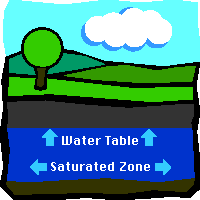
10) The Quran on Groundwater:
When the verses of the Quran concerning the role of water in man's existence are read in succession today, they all appear to us to express ideas that are quite obvious. The reason for this is simple: in our day and age, we all, to a lesser degree or greater extent, know about the water cycle in nature.
If however, we consider the various concepts the ancients had on this subject, it becomes clear that the data in the Quran do not embody the mythical concepts current at the time of the Revelation which had been developed more according to philosophical speculation than observed phenomena. Although it was empirically impossible to acquire on a modest scale, the useful practical knowledge necessary for the improvement of the irrigation, the concepts held on the water cycle in general would hardly be acceptable today.
Thus it would have been easy to imagine that underground water could have come from the infiltration of precipitations in the soil. In ancient times however, this idea, held by Vitruvius Polio Marcus in Rome, 1st century B.C., was cited as an exception. For many centuries therefore (and the Quranic Revelation is situated during this period) man held totally inaccurate views on the water cycle.
Two specialists on this subject, G. Gastany and B. Blavoux, in their entry in the Universalis Encyclopedia, under the heading Hydrogeology give an edifying history of this problem.
"In the Seventh century B.C., Thales of Miletus held the theory whereby the waters of the oceans, under the effect of winds, were thrust towards the interior of the continents; so the water fell upon the earth and penetrated into the soil. Plato shared these views and thought that the return of the waters to the oceans was via a great abyss, the 'Tartarus'. This theory had many supporters until the Eighteenth century, one of whom was Descartes. Aristotle imagined that the water vapor from the soil condensed in cool mountain caverns and formed underground lakes that fed springs. He was followed by Seneca (1st century A.D.) and many others, until 1877, among them O. Volger... The first clear formulation of the water cycle must be attributed to Bernard Palissy in 1580: he claimed that underground water came from rainwater infiltrating into the soil. This theory was confirmed by E. Mariotte and P. Perrault in the Seventeenth century.
In the following passages from the Quran, there is no trace of the mistaken ideas that were current at the time of Mohammed:
Sura 50, verses 9 to 11:
"We sent down from the sky blessed water whereby We caused to grow gardens, grains for harvest, tall palm-trees with their spathes, piled one above the other - sustenance for (Our) servants. Therewith We gave (new) life to a dead land. So will be the emergence (from the tombs)."
Sura 23, verses 18 and 19:
"We sent down water from the sky in measure and lodged it in the ground. And We certainly are able to withdraw it. Therewith for you We gave rise to gardens of palm-trees and vienyards where for you are abundant fruits and of them you eat."
Sura 67, verse 30, God commands the Prophet:
"Say: Do you see if your water were to be lost in the ground, who then can supply you with gushing water?"
Sura 39, verse 21:
"Hast thou not seen that God sent water down from the sky and led it through sources into the ground? Then He caused sown fields of different colors to grow."
Sura 36, verse 34:
"Therein We placed gardens of palm-trees and vineyards and We caused water springs to gush forth."

Figure 1: Where does groundwater come from? Groundwater comes from rain, snow, sleet, and hail that soaks into the ground. The water moves down into the ground because of gravity, passing between particles of soil, sand, gravel, or rock until it reaches a depth where the ground is filled, or saturated, with water. The area that is filled with water is called the saturated zone and the top of this zone is called the water table. The top of the water is a table! The water table may be very near the ground surface or it may be hundreds of feet deep. (Groundwater.org)
The importance of springs and the way they are fed by rainwater conducted into them is stressed in the last three verses. It is worth pausing to examine this fact and call to mind the predominance in the Middle Ages of views such as those held by Aristotle, according to whom springs were fed by underground lakes.
Next: The Quran on the Origin of the Universe